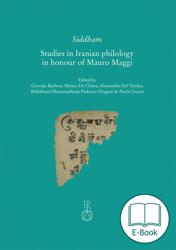This volume honours Mauro Maggi, celebrating his contributions to Iranian, Indo-Aryan, and Central Asian philology and linguistics. It includes twenty-nine papers from colleagues, former students, and friends, covering a wide array of languages and text traditions such as Avestan, Khotanese, Sogdian, Tumshuqese, Middle and Early New Persian, Bashkardi, Central dialects of Iran, Sanskrit, Gāndhārī, Tocharian, Chinese, Old Uigur, Tibetan, and Hebrew. The articles address philological and linguistic analyses, narrative motifs, translation techniques, and investigations into religious and literary traditions, offering a valuable resource for researchers and students.
This volume is a tribute to Mauro Maggi, celebrating his distinguished career and significant contributions in the fields of Iranian, Indo-Aryan, and Central Asian philology and linguistics. It features a diverse collection of papers presented by colleagues, former students, and friends, reflecting the broad spectrum of Mauro Maggi’s research interests. Along with an appreciation of the dedicatee and a comprehensive bibliography of his publications up to 2024, the book comprises twenty-nine articles. The main body of the volume focuses on various themes related to Khotanese and Central Asian languages and texts, approached from multiple perspectives — philologically, linguistically, etymologically, metrically, and interlinguistically. These studies explore the evolution of linguistic forms and structures, text edition and exegesis, translation techniques, and the transmission of cultural traditions across different regions and languages. Religious (primarily Buddhist), literary, and non-literary texts preserved in Central Asian manuscripts are also examined, not only from the perspective of Old and Late Khotanese, but also considering Sanskrit, Gāndhārī, Manichaean and Buddhist Sogdian, Tumshuqese, Tocharian A and B, Old Uigur, Chinese, and Tibetan. A selection of articles is dedicated to Western Iranian languages and texts, featuring discussions on textual analysis, narrative structures, linguistic description, and language contact. Complementing these are contributions on Zoroastrian traditions, delving into eschatological themes and mythological narratives. The volume also includes newly edited and translated literary and non-literary texts, providing fresh material for scholars and enriching the existing body of knowledge. This collection not only honours Mauro Maggi’s extensive scholarly contributions but also serves as a valuable resource for researchers in Iranian, Indo-Aryan, and Central Asian studies. It will be of interest and value to scholars of Iranian philology and linguistics, as well as those in Indo-European linguistics, Central Asian philology, and Buddhist literature. Through this comprehensive tribute, the volume underscores the lasting impact of Mauro Maggi’s work and his enduring legacy in the field.
The series Beiträge zur Iranistik was founded in the 1960s by Georges Redard and subsequently edited by Nicholas Sims-Williams from 1997 to 2020; the present series editor is Agnes Korn.
The series publishes works on the languages of the Iranian branch of Indo-European. The focus is on linguistics, including grammars, dictionaries, text editions, philology as well as diachronic and synchronic studies of linguistic topics. Neighbouring fields such as literature, archaeology and anthropology are likewise represented. The languages of the series are English, German and French. The Beiträge zur Iranistik are represented in libraries internationally and are widely used standard works of Iranian studies.


 Sample
Sample